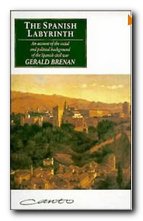political and historical origins of the Spanish Civil War
The Spanish Labyrinth is an important historical study in which a liberal humanist tries to understand why a catastrophic civil war took place in Spain between 1936 and 1939. Gerald Brenan was an auto-didactic but a very passionate historian with an enduring love for the country in which he made his home from 1919 until the war broke out – and to which he returned, living just outside Malaga from 1953 until his death in Alhaurín el Grande in 1987. He is buried in the English cemetery in Malaga.
 This account was written whilst the war was taking place, first published in 1943 then revised in 1950 with no changes to its central conclusion that the civil war had set Spain back fifty years. The end of the Franco regime didn’t come about until the mid 1970s, so that was not a bad analysis and prediction. The Spanish Labyrinth is not a history of the war but an account of its origins. Brenan explains complex issues such as the Catalonian separatist movement which resulted in a repository of political radicalism focussed in Barcelona – the principal centre of Spain’s manufacturing industry and one of the most important cities during the war.
This account was written whilst the war was taking place, first published in 1943 then revised in 1950 with no changes to its central conclusion that the civil war had set Spain back fifty years. The end of the Franco regime didn’t come about until the mid 1970s, so that was not a bad analysis and prediction. The Spanish Labyrinth is not a history of the war but an account of its origins. Brenan explains complex issues such as the Catalonian separatist movement which resulted in a repository of political radicalism focussed in Barcelona – the principal centre of Spain’s manufacturing industry and one of the most important cities during the war.
The first part of his account looks at the complex history of the relation between the Church and the Liberals. He sees the Catholic Church’s principal mistake as its failure to understand the French revolution and its antipathy to education. The church had historically been a supporter of the underdog against the state, but it was gradually poisoned by its proximity to power and became a force of reaction. Hence the anti-clerical violence during the war.
Brenan’s narrative trajectory is then interrupted by a detailed examination of the ‘Agrarian question’ in each of the main regions of Spain. This is followed by an in-depth account of the political philosophy of Mikhail Bukharin in order to explain why anarchism took such a powerful hold in Spain.
The central portion of the book is his analysis of Anarcho-Syndicalism in Spain – how it differed from other varieties in Europe, how it was a form of Utopian desire to return to a golden age of communal life in the pueblo, and why it ultimately failed.
Sometimes his historical narrative actually seems to be going backwards. No sooner do we arrive at the birth of the new Republic in 1931 than there is a historical detour going back to land divisions and sheep rearing in the thirteenth century.
The story really gets under way with strikes, bomb outrages, police informers, agents provocateurs, and military repression in the post 1918 period. King Alfonso XIII perpetrated reactionary disasters, and the net result of this was a seizure of power in 1923 by Primo de Rivera. His eccentric dictatorship lasted six years.
Elections in 1931 produced a Constituent Cortes which was composed of Anarch-Syndicalists, Socialists, and Republicans. Its first tasks were the establishment of a constitution, a solution to the agrarian question and Catalonian separatism, and the separation of Church and State. All of these issues proved too difficult to implement properly.
This was partly due to the fact that these were turbulent years There were military uprisings, strikes, the burning of churches, and a period of Dictatorship had left the economy in ruins. The more vigorously the government cracked down on disruptions, the more it fuelled the wrath of the anti-Republicans. And all these events were taking place against the backdrop of a World economic crisis. When new elections were held in 1933, all parties of the left suffered heavy defeats.
It is a very sad story of political squabbling, especially in retrospect with the knowledge what it all led to. Elections were still being rigged and votes bought; parties were being formed, split, and re-constituted like amoebas; and all the time the forces of reaction were growing stronger.
Brenan ends with an overview of political developments during the war. (For a comprehensive account of the war, see Anthony Beevor’s The Battle for Spain: The Spanish Civil War 1936-1939, George Orwell’s Homage to Catalonia, and Sir Raymond Carr’s The Spanish Tragedy). Brenan’s argument is that the war was won by Franco because of foreign intervention from his fellow fascists in Germany and Italy.
But it was also lost by the Republicans because of duplicity by Stalin, who was supposed to be offering support, but who used the war as a means of settling political scores with the Trotskyists and myriad opponents he saw from his paranoid hold on power. It might also be noted that within five months of the war’s ending, he had signed the Hitler-Stalin pact with his former ‘enemy’ as his entree to the Second World War. It is no wonder that Victor Serge, in his wonderful novel documenting this period, called these Unforgiving Years.
© Roy Johnson 2011
Gerald Brenan, The Spanish Labyrinth, New York: Cambridge University Press, new edition 1990, pp.404, ISBN: 0521398274
More on Gerald Brenan
More on the Bloomsbury Group
More on literary studies
More on short stories